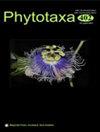Sparassis fanjingshanensis, a new species of Sparassidaceae from Fanjingshan National Nature Reserve in China
IF 1
4区 生物学
Q3 PLANT SCIENCES
引用次数: 0
Abstract
Sparassis fanjingshanensis is described as a new species of Sparassidaceae based on morphology and phylogenetic analyses in this study. It was found in Abies fanjingshanensis community of the massy dwarf forest to Fanjing Mountain, China, and this is the only site of its occurrence known to date. Phylogenetic analysis of the sequences based on the internal transcribed spacer (ITS), the nuclear ribosomal large subunit (LSU) and partial gene coding RNA polymerase subunit II (rpb2) indicated that Sparassis fanjingshanensis belonged to the genus Sparassis and it formed a novel monophyletic clade next to Sparassis subalpina. Sparassis fanjingshanensis can be distinctly distinguished by its large basidiomata and light-gray to light-khaki flabellae that is compactly arranged, entire, broadly spathulate, slightly contorted, surface glabrous, top margin undulate, smooth, stem with concentric ring ornamentation (similar to the annual rings of a tree). In total, up to now, four taxa have been found in East Asia: Sparassis cystidiosa f. labelliformis, Sparassis fanjingshanensis, Sparassis labelliformis and Sparassis subalpine.中国梵净山国家级自然保护区新发现的梵净山矛科矛属植物
根据形态学和系统发育分析,本研究将梵净山杉描述为杉木科(Sparassidaceae)的一个新种。它被发现于中国梵净山矮林中的梵净山杉群落中,这是迄今所知的唯一出现地点。基于内部转录间隔序列(ITS)、核糖体大亚基(LSU)和RNA聚合酶亚基II(rpb2)部分编码基因的系统发生学分析表明,扇京山杉属于杉属,并与Sparassis subalpina形成一个新的单系支系。Sparassis fanjingshanensis 的明显特征是基部具大的基瘤和浅灰色至浅卡其色的叶片,叶片排列紧凑、全缘、宽匙形、稍弯曲、表面无毛、顶缘波状、光滑,茎部具有同心环状装饰(类似于树木的年轮)。到目前为止,在东亚总共发现了 4 个分类群:Sparassis cystidiosa f. labelliformis、Sparassis fanjingshanensis、Sparassis labelliformis 和 Sparassis subalpine。
本文章由计算机程序翻译,如有差异,请以英文原文为准。
求助全文
约1分钟内获得全文
求助全文
来源期刊

Phytotaxa
PLANT SCIENCES-
CiteScore
1.90
自引率
27.30%
发文量
956
审稿时长
1 months
期刊介绍:
Phytotaxa is a peer-reviewed, international journal for rapid publication of high quality papers on any aspect of systematic and taxonomic botany, with a preference for large taxonomic works such as monographs, floras, revisions and evolutionary studies and descriptions of new taxa. Phytotaxa covers all groups covered by the International Code of Nomenclature foralgae, fungi, and plants ICNafp (fungi, lichens, algae, diatoms, mosses, liverworts, hornworts, and vascular plants), both living and fossil. Phytotaxa was founded in 2009 as botanical sister journal to Zootaxa. It has a large editorial board, who are running this journal on a voluntary basis, and it is published by Magnolia Press (Auckland , New Zealand). It is also indexed by SCIE, JCR and Biosis.
All types of taxonomic, floristic and phytogeographic papers are considered, including theoretical papers and methodology, systematics and phylogeny, monographs, revisions and reviews, catalogues, biographies and bibliographies, history of botanical explorations, identification guides, floras, analyses of characters, phylogenetic studies and phytogeography, descriptions of taxa, typification and nomenclatural papers. Monographs and other long manuscripts (of 60 printed pages or more) can be published as books, which will receive an ISBN number as well as being part of the Phytotaxa series.
 求助内容:
求助内容: 应助结果提醒方式:
应助结果提醒方式:


